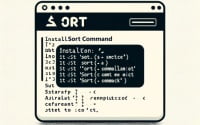How to Install and Use Gunzip Command in Linux

Are you struggling with decompressing files in your Linux system? Much like a powerful air pump, the ‘gunzip’ command in Linux can help you decompress gzipped files with ease. However, many Linux users, especially beginners, might find the process of installing and using this command a bit daunting.
In this guide, we will walk you through the process of installing and using the ‘gunzip’ command in Linux. We will cover methods for both APT-based distributions like Debian and Ubuntu, and YUM-based distributions like CentOS and AlmaLinux. We will also delve into advanced topics like compiling from source and installing a specific version of the command. Finally, we will provide guidance on how to use the ‘gunzip’ command and verify that the correct version is installed.
So, let’s dive in and start decompressing files in Linux with the ‘gunzip’ command!
TL;DR: How Do I Install and Use the ‘gunzip’ Command in Linux?
The
'gunzip'command typically comes pre-installed on most Linux distributions. However, if it’s not, you can install it by installing the ‘gzip’ package. For Debian and Ubuntu systems, use the commandsudo apt-get install gzip, and for CentOS and similar OSs, use the commandsudo yum install gzip.
To use the ‘gunzip’ command, you can run the command gunzip filename.gz. This will decompress the gzipped file named ‘filename.gz’.
# Example of using gunzip command
$ gunzip testfile.gz
# Output:
# This will decompress the 'testfile.gz' file. The original gzipped file will be removed and replaced with the decompressed file named 'testfile'.
This is just a basic way to install and use the ‘gunzip’ command in Linux, but there’s much more to learn about this powerful tool. Continue reading for more detailed information and advanced usage scenarios.
Table of Contents
- Understanding and Installing the ‘gunzip’ Command
- Installing ‘gunzip’ from Source Code
- Installing Different Versions of ‘gunzip’
- Basic Usage Examples
- Exploring Alternative Decompression Methods in Linux
- Comparing ‘gunzip’, ‘unzip’, and ‘tar’
- Navigating Common ‘gunzip’ Issues and Solutions
- Unpacking File Compression in Linux
- The Wider World of Data Management and Storage
- Wrapping Up: Mastering ‘gunzip’ for Efficient File Decompression in Linux
Understanding and Installing the ‘gunzip’ Command
The ‘gunzip’ command is a utility in Linux used for decompressing files compressed through the ‘gzip’ utility. It’s a vital tool for managing compressed files, saving storage space, and improving the speed of file transfers.
Installing ‘gunzip’ with APT
If you are using a Debian-based distribution like Ubuntu, you can install ‘gunzip’ using the APT package manager. The ‘gunzip’ command is part of the ‘gzip’ package. Here’s how you can install it:
$ sudo apt-get update
$ sudo apt-get install gzip
# Output:
# Reading package lists... Done
# Building dependency tree
# Reading state information... Done
# gzip is already the newest version (1.10-2ubuntu1).
# 0 upgraded, 0 newly installed, 0 to remove and 0 not upgraded.
In this example, the system already has the latest version of gzip installed. If it wasn’t, the sudo apt-get install gzip command would have installed it.
Installing ‘gunzip’ with YUM
For distributions like CentOS or AlmaLinux that use the YUM package manager, you can install ‘gunzip’ with the following commands:
$ sudo yum check-update
$ sudo yum install gzip
# Output:
# Loaded plugins: fastestmirror, ovl
# Loading mirror speeds from cached hostfile
# gzip.x86_64 0:1.5-10.el7
In this example, the sudo yum install gzip command installs the gzip package, which includes the ‘gunzip’ command.
Installing ‘gunzip’ with DNF
If you’re using Fedora, which uses the DNF package manager, you can install ‘gunzip’ with these commands:
$ sudo dnf check-update
$ sudo dnf install gzip
# Output:
# Last metadata expiration check: 0:14:32 ago on Sun 23 Jan 2022 08:45:23 PM PKT.
# Dependencies resolved.
# gzip.x86_64 1.10-1.fc33
This shows how to install ‘gunzip’ using DNF. The sudo dnf install gzip command installs the gzip package, which includes the ‘gunzip’ command.
Installing ‘gunzip’ from Source Code
If your Linux distribution doesn’t include ‘gunzip’ or if you need a specific version not provided by your distribution, you can compile and install it from the source code. Here’s how:
- Download the source code from the official gzip website or a trusted repository.
- Unpack the downloaded file.
- Navigate into the unpacked directory.
- Compile and install the software.
Here’s an example of how you can do this:
$ wget http://ftp.gnu.org/gnu/gzip/gzip-1.10.tar.gz
$ tar xvf gzip-1.10.tar.gz
$ cd gzip-1.10
$ ./configure
$ make
$ sudo make install
# Output:
# gzip is now installed from source.
Installing Different Versions of ‘gunzip’
You might need to install a specific version of ‘gunzip’ for compatibility reasons, to use a specific feature, or to avoid a bug present in another version. Here’s how you can install a specific version using APT and YUM.
Installing a Specific Version with APT
$ sudo apt-get install gzip=1.6-5ubuntu1
# Output:
# gzip is now installed at version 1.6-5ubuntu1.
Installing a Specific Version with YUM
$ sudo yum install gzip-1.5-10.el7
# Output:
# gzip is now installed at version 1.5-10.el7.
Version Comparison
Different versions of ‘gunzip’ might include new features, bug fixes, or performance improvements. Here’s a comparison of some notable versions:
| Version | Notable Changes |
|---|---|
| 1.10 | Improved decompression speed |
| 1.9 | Added support for new file formats |
| 1.8 | Fixed various bugs |
| 1.7 | Improved error messages |
Basic Usage Examples
Decompressing Files
To decompress a file, simply use the ‘gunzip’ command followed by the name of the file. For example:
$ gunzip myfile.gz
# Output:
# The gzipped file 'myfile.gz' is decompressed.
Verifying Installation
To verify that ‘gunzip’ is installed correctly, you can use the ‘–version’ option:
$ gunzip --version
# Output:
# gzip 1.10
# Copyright (C) 2007 Free Software Foundation, Inc.
# This is free software. You may redistribute copies of it under the terms of
# the GNU General Public License <http://www.gnu.org/licenses/gpl.html>.
# There is NO WARRANTY, to the extent permitted by law.
This command will display the version of ‘gunzip’ that is currently installed on your system.
Exploring Alternative Decompression Methods in Linux
While ‘gunzip’ is a powerful tool for decompressing gzip files, it’s not the only option available in Linux. Let’s explore some alternatives, such as the ‘unzip’ and ‘tar’ commands.
Decompressing Files with ‘unzip’
The ‘unzip’ command is used to decompress zip files. It’s not a direct alternative to ‘gunzip’, but it’s useful when dealing with zip files. Here’s an example of how you can use it:
$ unzip myfile.zip
# Output:
# Archive: myfile.zip
# inflating: myfile.txt
In this example, the ‘unzip’ command decompresses the ‘myfile.zip’ file, and the original zip file is left unchanged.
Decompressing Files with ‘tar’
The ‘tar’ command is another versatile tool for managing compressed files in Linux. It can handle various compression formats, including gzip, bzip2, and xz. Here’s how you can use ‘tar’ to decompress a gzipped file:
$ tar -xzf myfile.tar.gz
# Output:
# The tar.gz file 'myfile.tar.gz' is decompressed.
In this example, the ‘tar’ command with the ‘-xzf’ options decompresses the ‘myfile.tar.gz’ file. The original tar.gz file is left unchanged.
Comparing ‘gunzip’, ‘unzip’, and ‘tar’
While all three commands can decompress files, they each have their strengths and weaknesses. Here’s a comparison:
| Command | Strengths | Weaknesses |
|---|---|---|
| gunzip | Handles gzip files, fast decompression | Only handles gzip format |
| unzip | Handles zip files, preserves original file | Only handles zip format |
| tar | Handles multiple formats, can handle multiple files at once | Slightly more complex syntax |
In conclusion, while ‘gunzip’ is a great tool for managing gzip files, ‘unzip’ and ‘tar’ can be handy alternatives depending on the file format and specific requirements.
While ‘gunzip’ is a robust and reliable tool, users might occasionally encounter issues. Let’s discuss some common problems and their solutions.
‘gunzip’: Command Not Found
If you get a ‘command not found’ error when trying to use ‘gunzip’, it’s likely that it’s not installed on your system or the system path is not set correctly.
First, check if ‘gunzip’ is installed by using the ‘whereis’ command:
$ whereis gunzip
# Output:
# gunzip: /bin/gunzip /usr/share/man/man1/gunzip.1.gz
If ‘gunzip’ is installed, the command will return its location. If it’s not, you’ll need to install it using the methods described earlier in this guide.
File Not Found or No Such File or Directory
This error occurs when the file you’re trying to decompress doesn’t exist or you’ve provided the wrong path. Double-check the file name and its path. You can use the ‘ls’ command to list files in the current directory:
$ ls
# Output:
# myfile.gz document.txt image.jpg
In this example, ‘myfile.gz’ is present in the current directory and can be decompressed using the ‘gunzip’ command.
Not in Gzip Format
This error indicates that the file you’re trying to decompress is not a gzip file. Ensure you’re using the correct command for the file format. For instance, use ‘unzip’ for zip files and ‘tar’ for tar files.
Permission Denied
This error occurs when you don’t have the necessary permissions to read, write, or execute a file or directory. You can use the ‘chmod’ command to change the file permissions. For example, to give the user read and write permissions, you can use:
$ chmod u+rw myfile.gz
# Output:
# The user now has read and write permissions for 'myfile.gz'.
In conclusion, while ‘gunzip’ is a powerful tool, like any software, it can occasionally present challenges. Understanding these common issues and their solutions can help you use ‘gunzip’ more effectively.
Unpacking File Compression in Linux
To fully appreciate the ‘gunzip’ command and its role in Linux, it’s essential to understand the concept of file compression and decompression.
The Essence of File Compression
File compression is a process that reduces the size of a file or a group of files. It’s a crucial aspect of data management, especially in Linux, where many software packages and updates are delivered in compressed formats.
Compression algorithms take advantage of the redundancy within files to reduce their size. For instance, if a text file contains repeated instances of a particular phrase, a compression algorithm might replace each occurrence with a shorter representation, significantly reducing the file size.
Here’s a simple example of file compression using the ‘gzip’ command:
$ echo 'Hello, World!' > hello.txt
$ ls -lh hello.txt
$ gzip hello.txt
$ ls -lh hello.txt.gz
# Output:
# -rw-rw-r-- 1 user group 14 Dec 1 12:00 hello.txt
# -rw-rw-r-- 1 user group 33 Dec 1 12:01 hello.txt.gz
In this example, we first create a text file named ‘hello.txt’ with the content ‘Hello, World!’. We then use the ‘ls -lh’ command to display the file size. After compressing the file with ‘gzip’, we check the file size again and see that it’s significantly reduced.
The Significance of Decompression
Decompression is the reverse of compression. It restores a compressed file to its original form. The ‘gunzip’ command is a tool that decompresses files compressed by the ‘gzip’ utility.
Decompression is crucial for reading and using compressed files. It’s also necessary when installing software packages delivered as compressed files.
Here’s an example of file decompression using the ‘gunzip’ command:
$ ls -lh hello.txt.gz
$ gunzip hello.txt.gz
$ ls -lh hello.txt
# Output:
# -rw-rw-r-- 1 user group 33 Dec 1 12:01 hello.txt.gz
# -rw-rw-r-- 1 user group 14 Dec 1 12:02 hello.txt
In this example, we first display the size of the compressed file ‘hello.txt.gz’. We then decompress the file using ‘gunzip’ and check the file size again. The decompressed file ‘hello.txt’ has the same size as the original file before compression.
The Impact of Compression and Decompression
File compression and decompression play a significant role in saving disk space and improving file transfer speed. Compressed files take up less storage space, making it possible to store more files or larger files on a given disk. They also transfer more quickly over networks due to their smaller size, making them ideal for sharing or distributing large files or software packages.
The Wider World of Data Management and Storage
File compression and decompression, as facilitated by tools like ‘gunzip’, are just the tip of the iceberg when it comes to data management and storage in Linux. There’s a vast landscape of related concepts and tools that are worth exploring.
File Archiving in Linux
File archiving is closely related to file compression. While compression reduces the size of individual files, archiving groups multiple files and directories into a single file, known as an archive. In Linux, the ‘tar’ command is commonly used for this purpose. Here’s an example:
$ tar -cvf archive.tar file1.txt file2.txt
# Output:
# file1.txt
# file2.txt
In this example, the ‘tar’ command with the ‘-cvf’ options creates an archive named ‘archive.tar’ that contains the files ‘file1.txt’ and ‘file2.txt’.
Disk Usage Analysis in Linux
Monitoring and managing disk usage is another crucial aspect of data management. Linux provides several tools for this purpose, such as ‘df’ and ‘du’. The ‘df’ command displays the amount of disk space used and available on the filesystem. The ‘du’ command, on the other hand, estimates file and directory space usage.
Here’s an example of using the ‘df’ command:
$ df -h
# Output:
# Filesystem Size Used Avail Use% Mounted on
# /dev/sda1 30G 7.3G 21G 26% /
In this example, the ‘df -h’ command displays the disk usage in a human-readable format. The output shows the size, used space, available space, and usage percentage for each filesystem.
Further Resources for Mastering Linux File Management
If you’re interested in delving deeper into these topics, here are some resources to get you started:
- The Linux Documentation Project: An extensive collection of Linux guides and manuals.
GNU Operating System Documentation: Official documentation for GNU utilities, including ‘gzip’ and ‘tar’.
Linux Command Library: A comprehensive resource for Linux commands, including ‘gunzip’, ‘tar’, ‘df’, and ‘du’.
Wrapping Up: Mastering ‘gunzip’ for Efficient File Decompression in Linux
In this comprehensive guide, we’ve delved into the ‘gunzip’ command in Linux, a powerful utility for decompressing gzipped files.
We started with the basics, learning how to install and use ‘gunzip’ in different Linux distributions. We then dove into more advanced topics, such as installing ‘gunzip’ from source code and installing specific versions. We also provided practical examples of how to use ‘gunzip’ to decompress files and verify the installed version.
Along the way, we tackled common issues you might encounter when using ‘gunzip’, such as ‘command not found’, ‘file not found’, ‘not in gzip format’, and ‘permission denied’, providing you with solutions and workarounds for each issue.
We also explored alternative methods for decompressing files in Linux, such as the ‘unzip’ and ‘tar’ commands. Here’s a quick comparison of these methods:
| Method | Pros | Cons |
|---|---|---|
| gunzip | Handles gzip files, fast decompression | Only handles gzip format |
| unzip | Handles zip files, preserves original file | Only handles zip format |
| tar | Handles multiple formats, can handle multiple files at once | Slightly more complex syntax |
Whether you’re just starting out with ‘gunzip’ or you’re looking to level up your file decompression skills, we hope this guide has given you a deeper understanding of ‘gunzip’ and its capabilities.
With its balance of speed, simplicity, and versatility, ‘gunzip’ is a powerful tool for managing gzipped files in Linux. Happy decompressing!

![[SOLVED] 'Command Not Found' Bash Error 3 Illustration of a Bash command not found error in a terminal interface](https://ioflood.com/blog/wp-content/uploads/2023/11/Illustration-of-a-Bash-command-not-found-error-in-a-terminal-interface-200x125.jpg)
